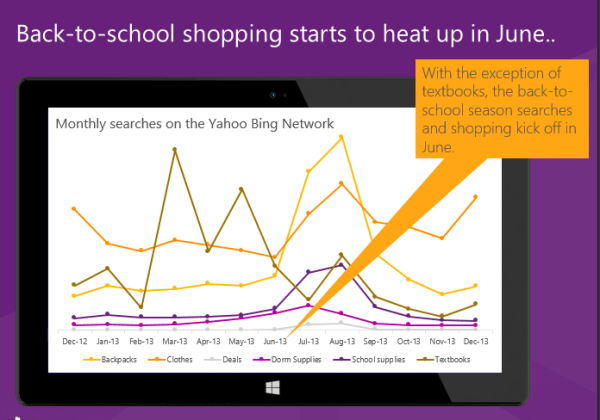Search Engine Marketing Helps Drive Back-to-School Sales
Summer may just be starting, but advertisers that want to do well this back-to-school shopping season need to plan now to make the most of this really impressive annual consumer shopping event. In fact, at an estimated $72.5 billion in combined back-to-school and back to college spending in 2013 [1], this is the second-largest retail event […]
Summer may just be starting, but advertisers that want to do well this back-to-school shopping season need to plan now to make the most of this really impressive annual consumer shopping event.
In fact, at an estimated $72.5 billion in combined back-to-school and back to college spending in 2013 [1], this is the second-largest retail event of the year, after the winter holidays.
What advertisers are best positioned to capitalize on this major seasonal event? Not surprisingly, 87 percent of the people we’ve surveyed report that school supplies are the No. 1 category. [2] Not far behind, at 82 percent, are clothing and apparel.
Personal banking services (hey, going back to school costs money!) and consumer electronics tie in the third spot, with 58 percent of respondents planning activity there.
Dorm supplies and furnishings (55 percent), media and entertainment (50 percent) and sporting goods (48 percent) round out the list. And toys — at 30 percent! Obviously, some people want to make back-to-school fun.
Clear Patterns In Back-to-School Shopping
We’ve looked closely at how the back-to-school season plays out, and have seen some interesting trends. For one thing, it is not a last-minute shopping season. People plan ahead and begin the hunt for back-to-school supplies early.
Some 23.9 percent start shopping more than two months before the first day of school. Another 49 percent do their shopping three weeks to one month before school. A relative minority of people — 21.8 percent — wait until the last week. [2]
That pattern becomes really clear when you track back-to-school-related searches over the course of the summer. Take a look at these two charts.
The implications of this for advertisers are obvious: you need to start your back-to-school campaigns early. Then, come the shopping peak in July/August, you’ll want to adjust bids and ad copy to make sure you don’t miss out on opportunities to capture back-to-school shoppers.
Notice, as well, the shopping pattern, with textbooks off to a fast start; backpacks, clothes and school supplies peaking right when July runs into August; and another peak for nearly all items just before the school year starts. Depending on what you are selling, you’ll want to adjust your campaign strategy accordingly.
It also pays to think carefully about what terms people use when searching for back-to-school items. We see quite a bit of variability in how back-to-school related terms are spelled, the order of words and how abbreviations are applied – and every year we see new variations not previously seen.
This could present an opportunity for advertisers if they are prepared. Consider how you utilize match types to increase the amount of relevant ad opportunities you are able to go after.
Searches also vary by device. Textbook searchers are popular on PCs and tablets during back-to-school season. Click-through rates for textbooks peaked in August last year, increasing 165 percent from June
On mobile devices, meanwhile, the click-through rate for clothing-related, back-to-school searches peaks earlier than on PCs and tablets. It started strong in June last year, and then gradually tapered off.
It’s also possible to manage your campaigns effectively by understanding back-to-school search patterns. For instance, on PCs and tablets, the lowest average cost-per-clicks across all categories are in June. The one exception is search for “deals.” So take advantage of low cost-per-clicks in outlying months.
Our research also shows how ad titles and copy can have an impact on results. We analyze millions of searches to learn what combinations work best, then generate “heat maps” that show the results.
Below, for instance, is a heat map generated by searches for retail for PC and tablets. Boxes that are green are good — the greener the better. I’ve inserted an arrow next to one green box, the convergence of “new” in the ad description, and “official” in the ad title performs well, meaning that an ad with a the word “new” in the description and “official site” in the title should be a strong ad.
The Right Tools Drive Sales
Be sure to use ad tools that help connect customers to your business. For instance, Location Extensions add information about your location to an ad, so customers can go right to your door.
Call Extensions add a click-to-call phone number, so you’re easy to contact.
Also, take advantage of Product Ads, which display your ad in a way that is visually compelling and include images, promotion text, pricing and your company name.
Broad Match modifiers, meanwhile, expand your ads’ reach by including words in your keywords in any order – not only the only the one you create – and by including words that are closely related to your keywords.
My last piece of advice: Don’t forget mobile. Mobile search traffic is exploding, and we anticipate an increase in mobile back-to-school search of 200 percent compared with last year. That’s huge!
With a solid search advertising campaign, you can make back-to-school a great time for your business. Get started on planning today.
Contributing authors are invited to create content for Search Engine Land and are chosen for their expertise and contribution to the search community. Our contributors work under the oversight of the editorial staff and contributions are checked for quality and relevance to our readers. The opinions they express are their own.
Related stories
New on Search Engine Land



